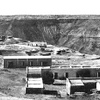Disclaimer
This entry contains information known to us from a variety of sources but may not include all the information currently available. Please be in touch if you notice any inadvertent mistakes in our presentation or have additional knowledge or sources to share. Thank you.
Archive
Giado Concentration Camp, Libya
Located about 250 kilometers south of Tripoli, Giado concentration camp (also spelled Jado), a former army base, was the harshest labor camp in Libya during WWII.1 After Mussolini’s order to evacuate all Jews, over 3,000 Jews were forced to go to concentration camps.2 Around 75% of those Jews, 2,600, came to Giado.3 The living conditions in the camp were inhuman.
Description
Life at Giado Concentration Camp
Survivor Shimon Teshuva recalls of Giado Concentration Camp:
Food rations were miserly, with some rice, oil, coffee, and sugar for sustenance.5 Some food could be purchased from local Muslims. The camp was made up of ten buildings, with 400 people living in each building. Sheets and blankets were hung to provide any semblance of privacy. One part of a building was converted to a small synagogue by Jews, with a Torah scroll, brought from Derna, Libya to use for worship.6 Men over 18 had to work every day for 12-hour shifts.7
There were no German administrators at Giado, thus the commanders of the camp were mainly Italian officers, and the guards were Arab and Italian policemen.8 They enjoyed embarrassing and harassing the prisoners.9 The chief commanding officer was Ettore Bastico.10
The camp was overcrowded, cold water was supplied rarely, and hygiene was nonexistent. Contagious diseases were common throughout the camp, like a typhus epidemic during December 1942.11 The dead were buried in an old abandoned Jewish cemetery, located on a hill outside the camp.12
The British came to the camp in January 1942. Weeks earlier, the guards of the camp fled, sensing imminent defeat, as well as 200 Jews wanting to escape the camp. Exactly 562 Jews died at Gaido concentration camp due to disease and deprived conditions, the highest number of Jewish victims in Islamic countries during WWII.13 Gradually, survivors returned to their homes for a while, but eventually all of them left Libya.14 There are no Jews in Libya today.15
WWII Libya
In 1911 Libya became an Italian colony. At the time there were around 21,000 Jews living in the country, the majority residing in Tripoli, Libya’s capital. Jews made up around 4% of the total population of 550,000. Jews lived among Muslims, Arabs, and Europeans.16 Until 1938, Libyan Jews lived in relative peace, but their situation became volatile, when the Fascist “Race Protection Laws” were instituted, severely restricting the freedom of Libyan Jews. Jews were not allowed to send their children to public or private Italian schools. They were restricted from state jobs and other professions. Marriages between “Aryans” and “non-Aryans” were prohibited, and each Jew had to have a “Jewish race” identification on their passport. By the beginning of WWII around 31,000 Jews lived in Libya, and in Tripoli one-quarter of the population was Jewish, with 44 synagogues in the city.17
By 1940, the war had reached Libya. Italy attacked Egypt, then a British colony, and was brutally defeated. Britain, in retaliation, entered Libya. In 1941, Germany came to Libya and pushed the British out. Between 1940 and 1942 Libya had changed hands around five times between British and German control.18 The Libyan Jews preferred to be under British control, due to no discriminatory treatment, and helped out the army as much as possible. However, when returned to Italian and German control, the Jews were brutally punished for their “alliance” with the enemy. Jewish cemeteries were ransacked and tombstones were used for fortification. In Tripoli, the Jewish quarter was used for Italian anti-aircraft positions, thus the area was constantly bombed. In one attack 30 Jews were killed, and four synagogues were destroyed.19
On February 7, 1942, Mussolini decided to move the Jews out of Cyrenaica territory, eastern Libya, into internment camps so that they would stop collaborating with the British.20 The campaign was called “sfollamento.” The most famous and brutal concentration camp in Tripolitania was the Giado concentration camp.21
Sources
Footnotes:
(1) "A Libyan Holocaust Survivor's Story." Point of No Return: Jewish Refugees from Arab Countries. April 8, 2013. Accessed July 06, 2016.
(2) Amiram Barkat. "A New Look at Libyan Jewry's Holocaust Experience." Haaretz, April 30, 2003.
(3) "What Was the Giado Concentration Camp?" Jimena: Jews Indigenous to the Middle East and North Africa. 2012.
(4) "A Libyan Holocaust Survivor's Story."
(5) Ochayon. "The Jews of Libya."
(6) Rachel Simon. "Giado Concentration Camp."
(7) Shmuel Spector, and Geoffrey Wigoder. “Benghazi” The Encyclopedia of Jewish Life before and during the Holocaust. A-J. New York: New York University Press, 2001: 111.
(8) Rachel Simon. "Giado Concentration Camp."
(9) Ochayon. "The Jews of Libya."
(10) Spector. “Benghazi,” 111.
(11) Rachel Simon. "Giado Concentration Camp."
(12) Ochayon. "The Jews of Libya."
(13) Ibid.
(14) Spector. “Benghazi,” 111.
(15) Ochayon. "The Jews of Libya."
(16) Ibid.
(17) Ibid.
(18) Ibid.
(19) Ibid.
(20) Rachel Simon. "Giado Concentration Camp." In Encyclopedia of Jews in the Islamic World, edited by Norman Stillman. Brill, 2010.
(21) Ochayon. "The Jews of Libya."
Works Cited:
"A Libyan Holocaust Survivor's Story." Point of No Return: Jewish Refugees from Arab Countries. April 8, 2013. Accessed July 06, 2016. http://jewishrefugees.blogspot.com/2013/04/a-libyan-holocaust-survivors-story.html.
Barkat, Amiram. "A New Look at Libyan Jewry's Holocaust Experience." Haaretz, April 30, 2003. http://www.haaretz.com/a-new-look-at-libyan-jewry-s-holocaust-experience-1.11501.
Camps De El Agheila Et De Giado. Http://www.musiques-regenerees.fr/GhettosCamps/MusiqueCamps3.html.
Ochayon, Sheryl. "The Jews of Libya." Yad Vashem. Accessed July 06, 2016. http://www.yadvashem.org/yv/en/education/newsletter/25/jews_libya.asp.
Simon, Rachel. "Giado Concentration Camp." In Encyclopedia of Jews in the Islamic World, edited by Norman Stillman. Brill, 2010.
Spector, Shmuel, and Geoffrey Wigoder. “Benghazi” The Encyclopedia of Jewish Life before and during the Holocaust. A-J. New York: New York University Press, 2001.
https://books.google.com/books?id=MFn3KeENnA0C&pg=PA111&lpg=PA111&dq=jado+concentration+camp&source=bl&ots=W37fpnkACD&sig=JUiwvIuBvwtjNvPGGEzRpDfN6zs&hl=en&sa=X&ved=0ahUKEwijhfbxlN7NAhXm1IMKHcDyCiMQ6AEIWDAI#v=onepage&q=jado%20concentration%20camp&f=false
"What Was the Giado Concentration Camp?" Jimena: Jews Indigenous to the Middle East and North Africa. 2012. http://www.jimena.org/wp_super_faq/what-was-the-giado-concentration-camp/.
